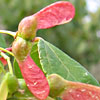Acer obtusifolium (Syrian Maple) is an evergreen tree with a single trunk that reaches a height of up to 5 m, sometimes even more. The leaves are opposite, simple, emarginated with 3 lobes, like the palm of the hand. Their margin is entire. They are hard to the touch, glabrous, and bright green. They have a diameter of 5 cm and are carried on a petiole that is 5 cm long.
Syrian Maple blooms in the spring, from March to May. The flowers are not prominent. They are small and greenish-yellowish, pollinated by wind, arranged in inflorescences. The inner leaves in the inflorescence are bisexual, the outer ones are unisexual. The fruit is equipped with two wings (double samara), which are 2 cm long. It is dry when ripe. The fruits are arranged in pairs, dangling. The fruit, and especially the wings, are blood red. Galls on the leaves are also prominently red.
Maple remains that were apparently used for building were found in the excavations of Tel Kabri and Tel Jezreel from the Early Bronze Age and the Iron Age.
The tree grows in humid Maquis in the Galilee and the Hermon, and is prominent in its ability to grow in cracked rocks and even on straight walls. It is not common in Israel. The global distribution of the species spreads only over Israel and Syria. Syrian Maple populations that grow in Israel comprise an endemic sub-species, and therefore deserve special protection.
In Israel, Syrian Maple is also used in gardening.
Acer is a large genus of trees, and includes 115 species, most of which grow in temperate regions of the Northern Hemisphere, on both sides of the Atlantic Ocean. Most are deciduous. Our species is unique in this aspect. Most are also much larger trees. Two species grow in Israel.
The fruit of all Acer species is a double samara with round opposite leaves, split-digitated into lobes, like the palm of the hand. Most of the species have large leaves, similar to those of the Fig or the Plane Tree. Some are famous for their bright red colors during their exfoliation season. Such trees are common and dense in certain mountainous regions of northeastern United States and southeastern Canada, and sometimes even dominate the cover of entire mountains. Hundreds of thousands of tourists flock there in October, especially in order to enjoy the splendor of the Maple’s exfoliation. It is no wonder that the Maple leaf (a red one) was chosen as the symbol on Canada’s flag. Maple species are also famous for the sugary sap that flows in the trunk’s tubes, a sap from which sweets and concentrated juice are produced (maple syrup). Maple is also famous among carpenters for the high quality and dense wood, and is used for the manufacture of furniture, floors, ships, car and airplane parts, musical instruments from the guitar to the drum, baseball bats, railway sleepers.
Maple is often planted for shade and in boulevards. Its flowers are not prominent. They are small and green. Nonetheless, the blossoming of an entire boulevard is impressive. Its bloom is an important source of nectar and pollen for honey bees.
Written by Mike Livne






